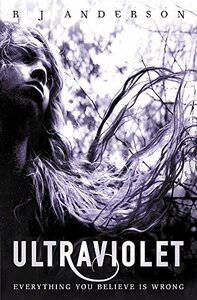Take a photo of a barcode or cover
Amazing book, I really liked the characterisations, no-one is perfect. Even the main character has her flaws. I also liked the fact that despite the setting being the same throughout most of the book, it didn't get boring. I also liked the descriptions relating to Alison's synaesthesia and the way it corresponded to the chapter titles, chapter 1 to 10 were colours and the rest were moods I believe. The ending was interesting with the revelation about Faraday and Tori but it wasn't done in a bad, gimmicky way which I liked a lot. I will definitely re-read this book and I await the next one :)
Overall rating: 3/5
Plot: 3/5
Char: 3/5
Hum: N/A
Rom: (the trouble was, I liked the romance but I didn't like how large the age gap was) 2/5
Writing style: 4.5/5
Warnings: None
(Maybe spoilers?)
Reading this book was a pleasure (thus the high WS rating) and I raced through it in an afternoon. Yet somehow the story and I just didn't quite click, which was odd because it has a lot of elements that I like like synesthesia, a very interesting look on mental hospitals and relationships when there's something different that people take to mean wrong about you. In fact, the only thing that I might actually fault would be that there was too much going on!
Still, I know a lot of people really loved it and maybe if I'd read it on a different day in a different mood I would have enjoyed it as much as them.
Plot: 3/5
Char: 3/5
Hum: N/A
Rom: (the trouble was, I liked the romance but I didn't like how large the age gap was) 2/5
Writing style: 4.5/5
Warnings: None
(Maybe spoilers?)
Reading this book was a pleasure (thus the high WS rating) and I raced through it in an afternoon. Yet somehow the story and I just didn't quite click, which was odd because it has a lot of elements that I like like synesthesia, a very interesting look on mental hospitals and relationships when there's something different that people take to mean wrong about you. In fact, the only thing that I might actually fault would be that there was too much going on!
Still, I know a lot of people really loved it and maybe if I'd read it on a different day in a different mood I would have enjoyed it as much as them.
3.5 stars. The first half was definitely more enjoyable than the second half but it was a good book all around. There were some nice quotes that I enjoyed also
ugh, started okay, but by the end it was ridiculous and I wanted all the hours I spent listening to this on audio back!
It's been awhile since I've read a book that really kept me guessing. Up until the last 50 pages or so, I really wasn't sure what to expect. I did think the book was a little unevenly paced (slow and deliberate for the first three-quarters, SUPER fast for the last fifty pages), but I liked this one. Interesting character, well written, unexpected. Stay tuned for a Bibliosnack entry on this one!
This and other reviews at http://lariswriting.blogspot.com
"Once upon a time there was a girl who was special. This is not her story. Unless you count the part where I killed her."
Alison is a 16 year old girl who wakes up in a mental hospital. She has no memory of how she got there, but as time and therapy soon show, her last memory before her psychological breakdown was of a fellow classmate, Tori, disintegrating.
Tori has since gone missing, and the community and police suspect Alison. She was the last one to see Tori and was found with Tori's blood on her hands. Alison believes that her rare abilities may have killed Tori.
Immediately, I picked up on the fact that the narrator is a synesthete. Synesthesia is when different neural pathways in the brain, connect different regions related to senses. Because of this, Alison can see music, taste voices, hear what she sees, etc. A very common form of synesthesia is assigning colors and personalities to numbers and letters. For example, in the image below, the left is how you would see the image if you were in the majority of the population, but the right is how you might view it if you had synesthesia:

Because of this rather fascinating character trait, the book, written in first person, is full of sensory descriptions, and it's totally appropriate because the character narrating the story is a synesthete! I loved the world the author painted for the reader from Alison's point of view, it was a huge brain treat.
Unfortunately, for Alison, her mother was scared of her daughter's phenomenal sense perception, and made made Alison ashamed of her sensory abilities. Because of this, Alison always hid what she could "see" from others. Eventually, Alison meets a friendly scientist with striking violet eyes, and as she starts to learn more about herself as he studies her at the mental institution.
The big part of the book, the part that has me still thinking, and what really made this work, is that Alison is most definitely NOT a reliable narrator. She is in a mental institution and evidence shows she may have murdered a classmate. As the book progresses, her perceptions of reality change drastically and her abilities as a synesthete begin to amplify (which isn't normal even for synesthetes).
I don't want discuss the end of the story because I fear to ruin it, but this novel definitely crosses a couple of genres, making it difficult for me to label (which is a good thing). I also think that because our narrator is so unreliable, the end of the story is rather open ended, as we have no one else confirming "what happened" other than Alison.
This novel is an amalgam of different genres; it is paranormal, a psychological thriller, a murder mystery, and even science fiction. As the reader begins to think they are in for a certain kind of story, they get pulled in a completely different direction. It also made me think about a lot of questions pertaining to the nature of an individual's perceptions and "absolute reality," and is there such a thing?
I would recommend this book to anyone. It's a lot of fun.
"Once upon a time there was a girl who was special. This is not her story. Unless you count the part where I killed her."
Alison is a 16 year old girl who wakes up in a mental hospital. She has no memory of how she got there, but as time and therapy soon show, her last memory before her psychological breakdown was of a fellow classmate, Tori, disintegrating.
Tori has since gone missing, and the community and police suspect Alison. She was the last one to see Tori and was found with Tori's blood on her hands. Alison believes that her rare abilities may have killed Tori.
Immediately, I picked up on the fact that the narrator is a synesthete. Synesthesia is when different neural pathways in the brain, connect different regions related to senses. Because of this, Alison can see music, taste voices, hear what she sees, etc. A very common form of synesthesia is assigning colors and personalities to numbers and letters. For example, in the image below, the left is how you would see the image if you were in the majority of the population, but the right is how you might view it if you had synesthesia:

Because of this rather fascinating character trait, the book, written in first person, is full of sensory descriptions, and it's totally appropriate because the character narrating the story is a synesthete! I loved the world the author painted for the reader from Alison's point of view, it was a huge brain treat.
Unfortunately, for Alison, her mother was scared of her daughter's phenomenal sense perception, and made made Alison ashamed of her sensory abilities. Because of this, Alison always hid what she could "see" from others. Eventually, Alison meets a friendly scientist with striking violet eyes, and as she starts to learn more about herself as he studies her at the mental institution.
The big part of the book, the part that has me still thinking, and what really made this work, is that Alison is most definitely NOT a reliable narrator. She is in a mental institution and evidence shows she may have murdered a classmate. As the book progresses, her perceptions of reality change drastically and her abilities as a synesthete begin to amplify (which isn't normal even for synesthetes).
I don't want discuss the end of the story because I fear to ruin it, but this novel definitely crosses a couple of genres, making it difficult for me to label (which is a good thing). I also think that because our narrator is so unreliable, the end of the story is rather open ended, as we have no one else confirming "what happened" other than Alison.
This novel is an amalgam of different genres; it is paranormal, a psychological thriller, a murder mystery, and even science fiction. As the reader begins to think they are in for a certain kind of story, they get pulled in a completely different direction. It also made me think about a lot of questions pertaining to the nature of an individual's perceptions and "absolute reality," and is there such a thing?
I would recommend this book to anyone. It's a lot of fun.
The story focuses on Alison, a teenage girl with Synesthesia, who finds herself in a mental institution after killing the most popular girl in School, but not is all that it seems!
I really loved the story, and couldn't put the book down wanting to know what happened to her, to Tori and the other characters in the story.
I really loved the story, and couldn't put the book down wanting to know what happened to her, to Tori and the other characters in the story.




